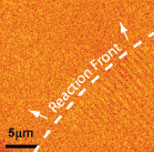
Observing transient behavior—how a chemical reaction, structural deformation or phase transformation takes place—is key to understanding many of the basic phenomena at the heart of chemistry, biology and materials science. The ability to directly observe and characterize these complex events leads to a fundamental understanding of properties such as reactivity, stability, and strength, and allows us to define models that aid in the design of new and improved materials and devices.
The Dynamic Transmission Electron Microscope (DTEM) at LLNL provides the ability to image this transient behavior with an unprecedented combination of spatial and temporal resolution: nanometers and nanoseconds. To achieve this level of resolution, researchers at LLNL redesigned the standard electron source and operation procedures for a TEM to enable a large pulse of electrons (>109 electrons) to be generated by photoemission and then manipulated in the microscope to form high-resolution images. It is the generation and manipulation of this short pulse containing a large number of electrons that enables the transient process being studied to be imaged in a single shot, permitting very fast, irreversible phenomena to be studied in detail for the first time.
Science in Support of National Objectives
The DTEM supports many of the research programs within LLNL and is being used to develop strong collaborations with leading university faculty and industrial researchers throughout the US. In particular, the microscope is being used to perform experiments that provide new insights into deformation and phase transformations in structural materials, nucleation and growth in nanoscale systems, the activity and reactivity of catalysts, and radiation effects in structural biology. These research topics are strongly aligned with the main missions of both LLNL and the US Department of Energy, having an impact on our understanding of the science critical to US stockpile stewardship, homeland security, and energy security.
Major Accomplishments
The development of an operational TEM that allows us to take snapshots of dynamic processes on the nanometer and nanosecond scales is a significant advance over previous experimental capabilities—standard high-resolution TEMs have only millisecond time resolution and ultrafast electron diffraction (UED) does not have the signal levels for single shot experiments or real-space images. While the current technology already allows us to examine nonequilibrium phenomena of major importance to the development of nanotechnology, the blueprint for an even more versatile instrument has also been defined. Modifications to the microscope are currently being implemented that will significantly increase the beam current, leading to higher spatial resolution, and enabling us to obtain movies of the transient process. As more is learned of the photoemission process and image formation mechanism, the temporal resolution is expected to increase also, leading to the ability to study materials under extreme conditions.
Scientific Impact
The development of the DTEM opens up a new paradigm for materials characterization under nonequilibrium and/or extreme process conditions. Prior to the DTEM, a fundamental understanding of the processes involved had to be determined from post-mortem analysis of the final result (equivalent to reconstructing a crash site or crime scene after the event). With the DTEM we can image the process itself, opening our eyes to the reason why the result happens, thereby reducing the number of tests needed and providing key insights to controlling the process. The flexibility of the TEM and the ability to image the transient phenomena means that there is no limitation to the materials that can be analyzed by these methods.

One area of research where the DTEM is providing unique information is the study of alternating nanoscale layers of transition metals that react to form intermetallic compounds in an exothermic reaction—called reactive multilayer foils (RMLF). After the intermetallic formation is first initiated, heat is generated into the surrounding foil volume causing a chain reaction that propagates along the interfaces up to the ends of the foil. Since RMLFs produce extremely high heat over a small surface area, they are useful to join dissimilar materials such as a metal and ceramic, exposing only the contact surfaces to destabilizing heat. The nature of the intermetallic phase formation process and rate limiting mechanisms such as interface diffusion or kinetics remain unclear. Studying the morphology, microstructure, and time scales of the transient intermetallic phases in the DTEM will give a detailed sequence of events in the foils and also clarify the general science of diffusion-controlled reactions.
Related Publications
Kulovits, A., et al., "Revealing the Transient States of Rapid Solidification in Aluminum Thin Films using Ultrafast in situ Transmission Electron Microscopy," Phil Mag Letts 91, 287 (2011).
Nikolova, L., et al., "Nanocrystallization of Amorphous Germanium Films Observed with Nanosecond Temporal Resolution," Applied Phys Letts 97, 203102 (2010).
Masiel, D. J., et al., "Time-Resolved Annular Dark Field Imaging of Catalyst Nanoparticles," ChemPhysChem 11, 2088 (2010).
Campbell, G. H., et al., "Quantifying Transient States in Materials with the Dynamic Transmission Electron Microscope," J Electron Microsc 1-8, 1 (2010).
Reed, B. W., et al., "Solving the Accelerator-Condenser Coupling Problem in a Nanosecond Dynamic Transmission Electron Microscope," Rev. Sci. Inst. 81, 053706 (2010).
LaGrange, T., et al., "Strongly Driven Crystallization Processes in a Metallic Glass," Applied Phys Letts 94, 184101 (2009).
Kim, J. S., et al., "Imaging of Transient Structures Using Nanosecond in Situ TEM," Science 321, 1472 (2008).
Armstrong, M., et al., "Prospects for Electron Imaging with Ultrafast Time Resolution," Applied Phys Letts 90, 114101 (2007).
Armstrong, M., et al., "Practical Considerations for High Spatial and Temporal Resolution Dynamic Transmission Electron Microscopy." Ultramicroscopy 107, 356-367 (2007).
LaGrange, T. B., et al., "Single Shot Dynamic Transmission Electron Microscopy for Materials Science," Applied Physics Letters 89, 044105 (2006).
Research Team
- Geoffrey H. Campbell
- Thomas LaGrange
- Bryan W. Reed
- Joseph T. McKeown
- Melissa K. Santala
- Glenn Huete
- William J. DeHope
- Richard M. Shuttlesworth
Learn more
- Contact: Geoffrey Campbell, DTEM project leader
- Taking Ultrafast Snapshots of Material Changes (PDF), Science & Technology Review, November/December 2008




